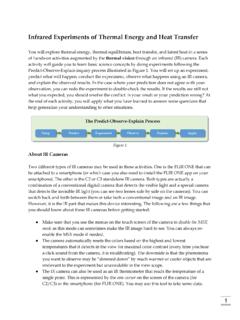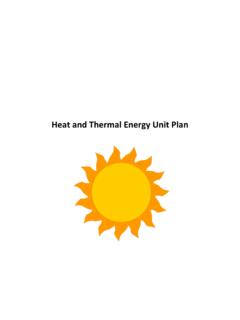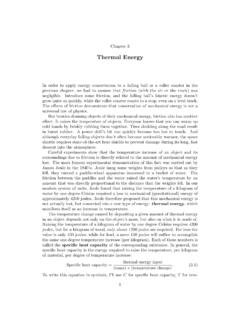Transcription of Physical Science Test – Form A Test 4: Thermal Energy
1 1 Physical Science Test form A Test 4: Thermal Energy 1. calorimeter 2. conduction 3. heat engine 4. heat pump 5. radiation 6. specific heat 7. temperature 8. Thermal insulator 9. thermodynamics 10. Thermal expansion A. a device which converts heat into work. B. A device which moves heat from cooler materials to warmer materials C. The amount of heat needed to raise the temperature of 1 gram of material by one degree Celsius. D. An increase in volume of a material due to an increase in temperature. E. An instrument used to measure changes in Thermal Energy or temperature. F. Material that allows heat to move easily through it. G. Material that does not allow heat to move easily through it. H. A measure of the average kinetic Energy of the particles in a material. I. The study of Thermal Energy converting into other forms of Energy . J. The transfer of Energy by waves moving through space.
2 K. The transfer of Thermal Energy by particles of a fluid carrying it around. L. The transfer of Thermal Energy through or within a material in direct contact with a heat source. 11. Which of the following is NOT a unit of measurement for temperature? a. Celsius degree b. Fahrenheit c. Joule d. Kelvin 12. The devices displayed above have a main function to a. convert heat into work b. convert kinetic Energy into potential Energy c. convert work into heat d. move heat from a cool area to a warm area 2 13. Energy from the sun reaches Earth by a process known as _____. a. conduction b. convection c. radiation d. both A and B 14. Which term describes how Energy is transferred when a heating pad is used to warm your hands? a. Conduction b. Convection c. Radiation d. Thermal expansion 15. On what does the amount of Thermal Energy of a substance depend? a. density and mass b.
3 Kinetic Energy and volume c. mass and temperature d. temperature and density 16. Which statement best desrcribes the direction of spontaneous heat flow? a. heat flows from an object at a lower temperature to one at a higher temperature. b. heat flows from an object at a higher temperature to one at a lower temperature. c. heat flows between objects at equal temperatures. d. heat does not flow. 17. Why can a refrigerator transfer Thermal Energy from the cold food department to the warm air? a. heat flows spontaneously from cold objects to hot objects. b. heat flows spontaneously from hot objects to cold objects. c. Work is done on the system. d. The process conserves Energy . 18. When fuels are burned to produce electricity, less than 50 percent of the Energy in the fuel is converted to electrical Energy . The rest of the Energy is a. used to run the power plant.
4 B. destroyed. c. converted to matter. d. converted to un-usable forms such as heat . 19. Suppose you blow up (inflate) a balloon in a warm classroom. What will happen if you take the balloon outdoors according to the rule of Thermal expansion? a. If the outdoor temperature is warmer than the indoor temperature, the balloon will shrink. b. If the outdoor temperature is colder than the indoor temperature, the balloon will shrink. c. If the outdoor temperature is the same as the indoor temperature, the balloon will increase in size. d. If it is raining outside, the balloon will pop. 20. What do you call the transfer of Thermal Energy when particles of a fluid move from one place to another? a. Radiation b. Insulation c. Convection d. Conduction 21. Box A and Box B are both set in the sun at the same time and both have an initial temperature of 30 C. After 30 minutes the final temperature for Box A was 32 C and the final temperature for Box B was 42 C.
5 Which box was made of material with a lower specific heat ? a. Box A since its temperature increases slower. b. Box B since its temperature increases faster. c. Both had the same specific heat . d. Cannot be determined by the information provided. 22. Using the same information from Question 20, what is the T for Box A? a. 2 C b. -2 C c. 12 C d. 62 C 23. As the kinetic Energy of an object increases so does its _____. a. potential Energy b. specific heat c. temperature d. mass 3 24. A thermometer level rises as an object gets hotter. This action is based on the rule of a. Thermal expansion b. conduction c. absolute zero d. heat pumps 25. In the formula Q = mC T, which variable is measured in Joules? a. Q b. M c. C d. T 26. Which of the following materials insulates heat well? a. iron b. copper c. air d. none of the above 27. Energy will not spontaneously flow from a _____ temperature to a _____ temperature.
6 A. higher; lower b. lower; higher c. hot; cold d. Energy does not flow. 28. It is impossible to build a machine that does nothing but convert Thermal Energy into useful work. This statement is true according to which law? a. Law of Thermal Expansion b. First Law of Thermodynamics c. Second Law of Thermodynamics d. Third Law of Thermodynamics 29. Which of the following statements explains the flow of heat when an ice cube melts in your hand? a. The heat travels from the ice cube to your hand. b. The heat travels from your hand to the ice cube. c. The heat goes no where; it is the coldness leaving the ice cube to your hand. d. heat does not flow. 30. An air conditioner is able to transfer heat from cold air to warm air. This ability is an example of the a. First Law of Thermodynamics b. Second Law of Thermodynamics c. Third Law of Thermodynamics d. Law of Thermal Expansion 31.
7 A calorimeter (above diagram) demonstrates the law of conservation which says that the Thermal Energy lost by the aluminum sample is _____ to the Thermal Energy gained by the water in the calorimeter. a. greater b. lesser c. equal d. not able to be determined 32. Radiant Energy from a light source is _____ when it strikes a dull and dark surface. a. Reflected b. Absorbed c. Converted to Thermal Energy d. Both B and C e. All of the above 33. Thermal Energy flows from a _____ to a _____ temperature. a. higher; lower b. lower; higher c. cold; colder d. Energy does not flow. 4 34. One consequence of the third law of thermodynamics is that a. engines cannot discharge waste heat . b. in some Energy conversions, Energy is not conserved. c. heat engines have work in not equal work out. d. None of the above 35. The diagram above is a representation of which type of Thermal Energy transfer?
8 A. Conduction b. Contraction c. Radiation d. Convection 36. Which of the following places the strokes of an internal combustion engine in correct sequential order? a. exhaust, compression, power, intake b. exhaust, power, compression, intake c. intake, power, compression, exhaust d. intake, compression, power, exhaust 37. How much quantity of heat must be transferred to a 420-g aluminum pizza pan to raise its temperature from 22 C to 232 C? a. 8,316 J b. 79, 380 J c. -79, 380 J d. 87, 676 J 38. A 10-g sample of iron is cooled from 42 C to 28 C. What is the quantity of heat lost by the sample? a. 63 J b. -63 J c. -189 J d. 189 J 39. A 50-g sample of lead is heated by 30 C. How much Thermal Energy is transferred to the lead sample? a. 195 J b. -195 J c. 1500 J d. -1500 J 40. A 50 kg sample of water is cooled by 20 C. Calculate the change in Thermal Energy for the water sample.
9 A. 4180 J b. -4180 J c. J d. J e. -4, 180, 000 J









